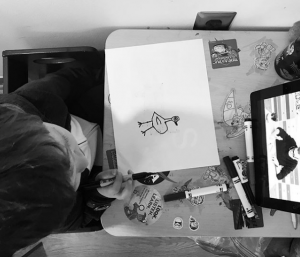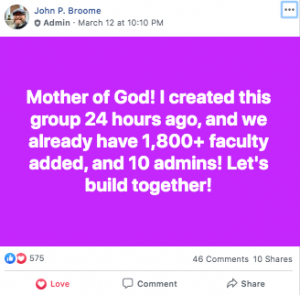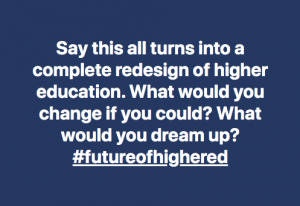Four years since my last post. FOUR YEARS. My kid turned five a few weeks ago. So I guess that makes some kind of sense. I started this blog nine years ago — as a privately-public space to ask and explore questions at the intersection of education, technology, and critical social theory. I’ve come and gone to blogging at random every since. But what has stayed the course in the last near-decade has been my passion for making sense of how education is both changing and being changed by technology.
As an educator actively researching and practicing 21st century education technologies, my professional life has increased in intensity since social distancing began in response to COVID-19. My duties not only include turning my classes into fully-online teaching and learning experiences, but also figuring out how to bring our literacy clinic online — a clinic that relies on people being able to come together and touch the same books.
 But I also am aware of the relative privilege I enjoy at this time of global crisis. No one who lives in my home is at high risk of contracting the virus, the people I hold dear are mostly in safe situations, and those who cannot be are able to take necessary precautions. And although my husband was furloughed from his job, he is eligible for unemployment, and we still have health benefits through my job as a college professor at a unionized institution of higher education. My child is on a screen longer than we’d like every day (3 hours or more), but he’s doing things like Lunch Doodles with Mo Willems. So at least it’s not all just passive intake of information?
But I also am aware of the relative privilege I enjoy at this time of global crisis. No one who lives in my home is at high risk of contracting the virus, the people I hold dear are mostly in safe situations, and those who cannot be are able to take necessary precautions. And although my husband was furloughed from his job, he is eligible for unemployment, and we still have health benefits through my job as a college professor at a unionized institution of higher education. My child is on a screen longer than we’d like every day (3 hours or more), but he’s doing things like Lunch Doodles with Mo Willems. So at least it’s not all just passive intake of information?
We are not at all okay, but by many measures, we are absolutely fine.
I came (back) here today to think out loud and begin to keep a record of what life has been like in my tiny corner of the world as a teacher educator in a rural college town.
The first major COVID-19 campus alert arrived on March 11, and we knew almost immediately: another shutdown is coming. Only no one realized it would be for the rest of the semester. No one was prepared for this.
A month earlier, we had evacuated campus for the better part of a week because of a temporary water contamination issue. Based on prior knowledge, we collectively assumed this would be like that: we’d leave for a spell and return, and then scramble (once again) to determine how to make up for lost time and physical proximity.
But this time, the alerts just kept coming. And in rapid succession, additional restrictions and policies were put into place. First, spring break was extended for a week. Then, the rest of the semester was moved to a distance learning model. Next, graduation was postponed. Then, the summer semester was moved completely online. And finally, what we all feared started to happen: people we know, work with, and teach began to become infected.
The unknowns and worries are growing exponentially by the day. So many questions abound — from topics of epidemiology and personal safety to those of workers’ rights and mass inequity. And watching this unfold in real time is, as someone said on NPR at the start of the pandemic, “like a slow-moving earthquake.” We are all wondering where it ends up. Wondering, what comes next?
higher ed learning collective begins
 When my Facebook colleague John Broome invited me to join a group he created to support educators in this transition to (mostly) online teaching, I immediately joined forces to help grow the effort. Having followed John for a while now on Facebook, I knew that his social media presence — and his unapologetically antiracist, feminist stance on all things everywhere — might just be the perfect catalyst for building a team of committed, social-justice-orientated educators-educating-educators at this time of widespread crisis. So it’s not surprising that the Higher Ed Learning Collective (HELC — website | FB group) has, in its first month in existence, turned into a force that may very well help shape where we go next in higher education.
When my Facebook colleague John Broome invited me to join a group he created to support educators in this transition to (mostly) online teaching, I immediately joined forces to help grow the effort. Having followed John for a while now on Facebook, I knew that his social media presence — and his unapologetically antiracist, feminist stance on all things everywhere — might just be the perfect catalyst for building a team of committed, social-justice-orientated educators-educating-educators at this time of widespread crisis. So it’s not surprising that the Higher Ed Learning Collective (HELC — website | FB group) has, in its first month in existence, turned into a force that may very well help shape where we go next in higher education.
 On March 26, I posed a question to the HELC community: “Say this all turns into a complete redesign of higher education. What would you change if you could? What would you dream up?” The responses really got me thinking about how many chips are in the air right now. And who benefits, and who doesn’t, when they inevitably fall.
On March 26, I posed a question to the HELC community: “Say this all turns into a complete redesign of higher education. What would you change if you could? What would you dream up?” The responses really got me thinking about how many chips are in the air right now. And who benefits, and who doesn’t, when they inevitably fall.
As campuses grapple with how to manage the fallout of shuttering bricks and mortar buildings to campus community members for the foreseeable future, and the pandemic remains ever difficult to contain, it doesn’t seem out of the question that we may be looking at an online fall semester, too. Given the trajectory we’re on, it’s hard to imagine where this ends. And what higher education looks like when it does.
In the meantime, I’m really grateful to be part of a community of people in higher education going through a shared experience, connected through the ether. #inthistogether #helc
our future, together
As a fierce union advocate and teacher of future teachers, I stand by the theory that everything we do in the classroom is an intentional act of either reproducing or resisting society as it is. As cracks in the surface of our capitalist world deepen in the midst of the COVID-19 crisis, we face an opportunity to rethink our future — to rethink education, forever.
Not everyone will agree politically (or practically) on what our potential educational future looks like, but one thing most of us seem to agree on is that it cannot stay the way it is (or was). There are plenty of essays roaming our feeds that say as much (more eloquently than I have here). And I’m ready to think out loud about how we get there.
Comments by